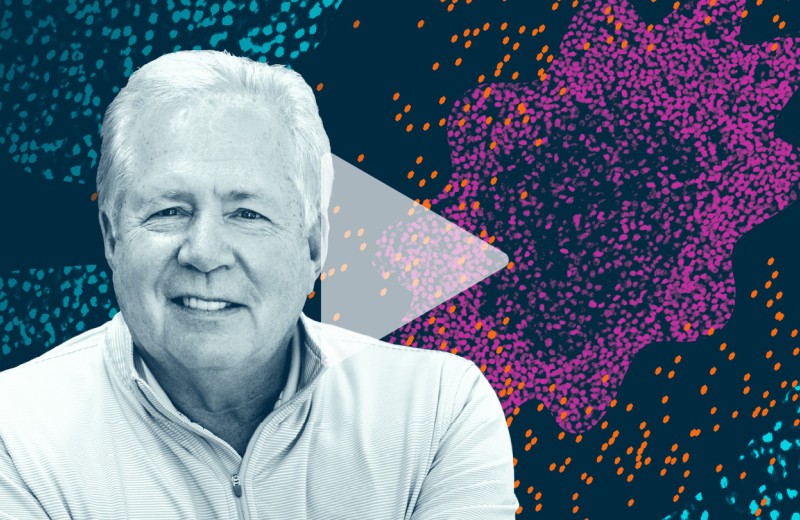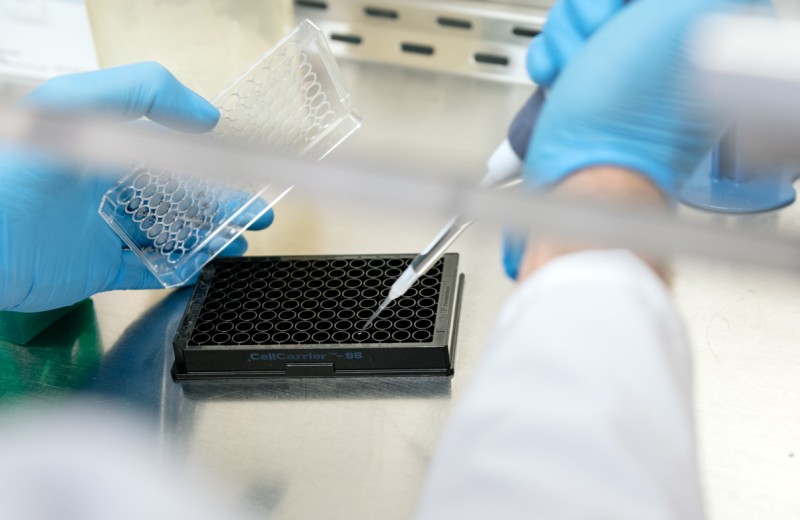Gladstone NOW: The Campaign Join Us on the Journey✕

SAN FRANCISCO, CA—Scientists at the Gladstone Institute of Virology and Immunology (GIVI) have discovered a new agent that might inhibit the infectivity of HIV. The agent, surfen, impairs the action of a factor in semen that greatly enhances the viral infection. Surfen might be used to supplement current HIV microbicides to greatly reduce HIV transmission during sexual contact.
The discovery was made by Nadia Roan, PhD, a senior fellow in the laboratory of GIVI Director Warner Greene, MD, PhD. Surfen is a small molecule that inhibits the actions of certain polysaccharide molecules called heparan sulfate proteoglycans (HSPG) that are found on the surface of cells. Importantly for HIV infection, it also interferes with the action of semen-derived enhancer of viral infection (SEVI). The discovery was published in the current issue of the Journal of Biological Chemistry.
“Surprisingly, although HIV readily replicates once inside the body, the virus struggles to establish a beachhead of infection during sexual transmission,” said Greene, who is senior author on the study. “We have been studying SEVI, a naturally occurring factor present in semen that can make HIV thousands of times more infectious. Knowing more about surfen, a SEVI inhibitor, might enable us to lower transmission rates of HIV.”
SEVI is a breakdown product of prostatic acid phosphatase, a common protein in semen. Under certain conditions, SEVI can increase HIV infectivity 100,000 times by facilitating the attachment of viruses to target cells. Because the majority of all HIV infections are thought to result from sexual contact (during which semen is either the vehicle carrying HIV or is present during the infection process), SEVI might have a significant impact on HIV transmission rates. Surfen interferes with the binding of SEVI to both target cells and HIV-1 virions but does not cause the SEVI fibrils to break up.
“Because SEVI can so greatly enhance HIV infectivity, supplementing current HIV microbicide candidates with SEVI inhibitors, such as surfen, might increase their potency and overall effectiveness,” Greene explained.
Previously, the researchers found that negatively charged polymers, such as heparin sulfate, interfere with the binding of SEVI to target cells. This led them to hypothesize that the SEVI fibrils bind target cells by interacting with cell-surface HSPG, naturally occurring anionic carbohydrate polymers with a structure that is closely related to heparin sulfate.
“SEVI has eight basic amino acids which makes this factor very positively charged,” said Roan, lead author on the study. “In previous work, we showed that the ability of SEVI to enhance infection was dependent on these positive charges. We reasoned that these positive charges may be interacting with negatively charged groups on HSPG of target cells.”
The scientists looked for antagonists of HSPG that might interfere with the binding of SEVI to the virus and target cells. They focused on surfen (bis-2-methyl- 4-amino-quinolyl-6-carbamide), which was first described in 1938 and reported to have anti-inflammatory and anti-bacterial activity. The team found that surfen inhibits enhancement of HIV-1 infection mediated by pure SEVI or semen. They further demonstrated that surfen interferes with the binding of SEVI to both target cells and HIV-1 virions.
“Because SEVI can markedly influence HIV infectivity, it forms a rather attractive target for future therapies” said Greene. “For example, we might be able to create combination microbicides that include agents targeting both the virus and host factors promoting infection. Such combinations might greatly diminish the spread of HIV; it is a target we are energetically pursuing.”
Additional contributors to the research include Gladstoneís Stefanie Sowinski, and Jan Munch and Frank Kirchhoff from the University Clinic of Ulm, Germany. The work was supported by the Giannini Foundation and the National Institutes of Health/NIAID grant #P01AI083050.
Dr. Greene's primary affiliation is with the Gladstone Institute of Virology and Immunology where he is senior investigator and the Nick and Sue Hellmann Distinguished Professor of Translational Medicine and where his laboratory is located and his research is conducted. He is also professor of medicine, microbiology and immunology at UCSF and co-director UCSF-GIVI Center for AIDS Research
40 Years of HIV Research: Celebrating the Career of Virologist Warner Greene
40 Years of HIV Research: Celebrating the Career of Virologist Warner Greene
Colleagues look back on Warner Greene's 40 year career
Gladstone Experts History HIV/AIDS Infectious Disease Greene LabTips from Virologists to Face the “Tripledemic” This Holiday Season
Tips from Virologists to Face the “Tripledemic” This Holiday Season
Gladstone scientists answer questions about the convergence of COVID-19, RSV, and the flu this winter
Gladstone Experts COVID-19 Infectious Disease Greene Lab Ott Lab Roan LabWhen Will This Pandemic End?
When Will This Pandemic End?
And other questions you have about Omicron and the pandemic
Gladstone Experts COVID-19 Infectious Disease Greene Lab Ott Lab Roan Lab



